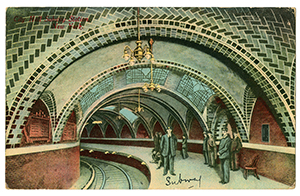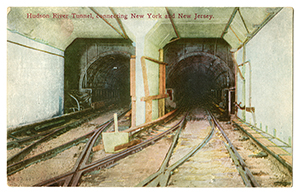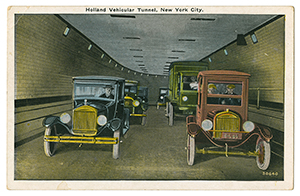Postcards from Under New York
Wed, Apr 8, 2020 12am - Sun, Jun 14, 2020 11:59pm

The Joseph Covino Postcard Collection
This digital exhibition—adapted from a 2010 hallway exhibition curated by Barb Choit—presents images from the Joseph Covino Postcard Collection* supplemented by historical maps and photographs. Dating from the late 19th to mid-20th century, the Collection is among the largest of its kind. Its nearly 3,800 postcards were donated to the Architecture Archive between 1999 and 2003 by Joseph Covino, an avid postcard collector. Most of the postcards document New York City’s built environment and infrastructure, including many no-longer-extant buildings, interiors, businesses, and public spaces. They record a city in constant flux, capturing several decades of urban development across all five boroughs, from the City’s piers, airports, subways, and armories to its public parks, aquariums, monuments, and libraries.
These postcards attest to the diverse commercial and public interests that shaped both the subjects they depict and their own role as mass communication media. In addition to recording the City’s evolving physical form, the postcards are commercial artifacts marking the rise of consumer culture, the growth of middle-class tourism, and the development of publishing technologies that fostered their widespread distribution and explosion in popularity during the first decades of the 20th century.
The postcards are supplemented with photographs that reveal both what is absent from their images, and how the images themselves were constructed. Some of the photographs provide historical context and details not included in the Collection, such as documentation of the 28th street IRT station and the Holland Tunnel’s construction. Other photographs, which were used by publishers as the basis for their reproductions, reveal the extent to which postcard images were routinely manipulated and enhanced for mass consumption.
Under New York
The postcards in this exhibition document New York City’s underground transit system at its inception. Stamp cancellations and postal rates indicate that the postcards date to as early as 1906—two years after the City’s first subway system, known as the IRT (Interborough Rapid Transit), officially opened to the public. They depict views of IRT subway tunnels and stations in Manhattan and Brooklyn, including the Brooklyn Tunnel, which connected Brooklyn Bridge and Borough Hall Stations via the East River; views of the Hudson & Manhattan Railroad—which later became the PATH system; and images of Holland and Lincoln Tunnels, which opened—in 1927 and 1937 respectively—as roadways connecting Manhattan and New Jersey.

The move to underground travel in New York City was not just a practical solution to above-ground congestion—it was a modern innovation that stirred public pride and sentiment. This is evidenced by the very existence of these postcards which promote underground travel as a New York City attraction, complete with inscriptions that convey an element of excitement. The handwritten text on one postcard depicting the Loop Station at City Hall, dated September 14, 1906, states only “When you come down to New York you must go through the Subway.”
Many of these postcards were souvenirs commemorating the opening of a specific structure—the IRT’s 23rd Street Station is presented as shining, immaculate, and so new that it is still empty of passengers. Some postcards depict the construction process, such as an image of the McAdoo Tunnel showing ropes, lumber, and a half-bored wall, inscribed with the text; “Where the construction parties met in the centre of the McAdoo Tunnel, NY.”

Many of the postcards also illustrate—in a manner legible to the average resident or tourist—how these underground structures relate to their more familiar aboveground environment. This is evident in one of the most striking representational styles in this exhibition—‘split view’ cards, in which two images of the same structure, one view from aboveground and one from below, are stacked within a single vertical frame. A sectional view is suggested through the visual proximity and vertical arrangement of two miniature vignettes, each with its own scale, perspective, and often, color scheme. The average viewer can read the connection between above- and belowground spaces through proximity rather than though trade-specific, technical images. The result is not a logical representation of how an underground tunnel structurally relates to what lies above it, but a simultaneous presentation of the way in which two separate experiences connect.

This collection of postcards represents not just what was being built under New York City in the early 20th century, but how it was being culturally promoted and received. At the time, these views were important for comprehending new, unseen spaces made possible through advances in technology and infrastructure. Some of these spaces—such as the 19th Street Hudson Line Station, the 18th Street Station at 6th Avenue, and the much celebrated City Hall Loop—have since been shuttered, rendered obscure and obsolete by new technologies, but they remain accessible through these postcards.
— Barb Choit and Chris Dierks (revised/edited, March 2020)
*With generous support from Jack Eichenbaum, ChE '63, the School of Architecture Archive is digitizing the entire Joseph Covino Postcard Collection for web-based, public access.




